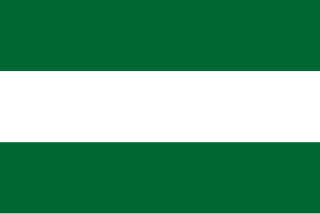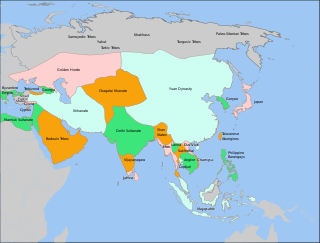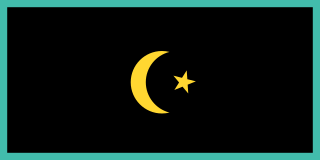Related Research Articles

The Durrani Empire, or the Afghan Empire, also known as the Sadozai Kingdom, was an Afghan empire founded by the Durrani tribe of Pashtuns under Ahmad Shah Durrani in 1747, which spanned parts of Central Asia, the Iranian plateau, and the Indian subcontinent. At its peak, it ruled over present-day Afghanistan, much of Pakistan, parts of northeastern and southeastern Iran, eastern Turkmenistan, and northwestern India. Next to the Ottoman Empire, the Durrani Empire is considered to be among the most significant Islamic empires of the second half of the 18th century.
The Uzbeks are a Turkic ethnic group native to the wider Central Asian region, being among the largest Turkic ethnic group in the area. They comprise the majority population of Uzbekistan, next to Kazakh and Karakalpak minorities, and are also minority groups in Afghanistan, Tajikistan, Kyrgyzstan, Kazakhstan, Turkmenistan, Russia, and China. Uzbek diaspora communities also exist in Turkey, Saudi Arabia, United States, Ukraine, Pakistan, and other countries.

The Great Game was a rivalry between the 19th-century British and Russian empires over influence in Central Asia, primarily in Afghanistan, Persia, and Tibet. The two colonial empires used military interventions and diplomatic negotiations to acquire and redefine territories in Central and South Asia. Russia conquered Turkestan, and Britain expanded and set the borders of British colonial India. By the early 20th century, a line of independent states, tribes, and monarchies from the shore of the Caspian Sea to the Eastern Himalayas were made into protectorates and territories of the two empires.
The Kara-Khanid Khanate, also known as the Karakhanids, Qarakhanids, Ilek Khanids or the Afrasiabids, was a Karluk Turkic khanate that ruled Central Asia from the 9th to the early 13th century. The dynastic names of Karakhanids and Ilek Khanids refer to royal titles with Kara Khagan being the most important Turkic title up until the end of the dynasty.

Kunduz is a city in northern Afghanistan, the capital of Kunduz Province. The city has an estimated population of about 268,893 as of 2015, making it about the 7th-largest city of Afghanistan, and the largest city in northeastern Afghanistan. Kunduz is in the historical Tokharistan region of Bactria, near the confluence of the Kunduz River with the Khanabad River. Kunduz is linked by highways with Kabul to the south, Mazar-i-Sharif to the west, and Badakhshan to the east. Kunduz is also linked with Dushanbe in Tajikistan to the north, via the Afghan dry port of Sherkhan Bandar. This city is famous in Afghanistan for its watermelon production.

The Delhi Sultanate or the Sultanate of Delhi was a late medieval empire primarily based in Delhi that stretched over large parts of the Indian subcontinent, for 320 years (1206–1526). Following the invasion of South Asia by the Ghurid dynasty, five dynasties ruled over the Delhi Sultanate sequentially: the Mamluk dynasty (1206–1290), the Khalji dynasty (1290–1320), the Tughlaq dynasty (1320–1414), the Sayyid dynasty (1414–1451), and the Lodi dynasty (1451–1526). It covered large swaths of territory in modern-day India, Pakistan, and Bangladesh as well as some parts of southern Nepal.

The Chagatai Khanate, or Chagatai Ulus was a Mongol and later Turkicized khanate that comprised the lands ruled by Chagatai Khan, second son of Genghis Khan, and his descendants and successors. At its height in the late 13th century the khanate extended from the Amu Darya south of the Aral Sea to the Altai Mountains in the border of modern-day Mongolia and China, roughly corresponding to the area once ruled by the Qara Khitai.

Rohillas are a mixed Indian community of Pashtun heritage, historically found in Rohilkhand, a region in the state of Uttar Pradesh, India. It forms the largest Pashtun diaspora community in India, and has given its name to the Rohilkhand region. The Rohilla military chiefs settled in this region of northern India in the 1720s, the first of whom was Ali Mohammed Khan.

The Turco-Mongol or Turko-Mongol tradition was an ethnocultural synthesis that arose in Asia during the 14th century among the ruling elites of the Golden Horde and the Chagatai Khanate. The ruling Mongol elites of these khanates eventually assimilated into the Turkic populations that they conquered and ruled over, thus becoming known as Turco-Mongols. These elites gradually adopted Islam, as well as Turkic languages, while retaining Mongol political and legal institutions.

The Khanate of Khiva was a Central Asian polity that existed in the historical region of Khwarazm from 1511 to 1920, except for a period of Afsharid occupation by Nader Shah between 1740 and 1746. Centred in the irrigated plains of the lower Amu Darya, south of the Aral Sea, with the capital in the city of Khiva. It covered present-day western Uzbekistan, southwestern Kazakhstan and much of Turkmenistan before the Russian conquest at the second half of the 19th century.

The Khanate of Bukhara was an Uzbek state in Central Asia from 1501 to 1785, founded by the Abu'l-Khayrid dynasty, a branch of the Shaybanids. From 1533 to 1540, Bukhara briefly became its capital during the reign of Ubaydallah Khan. The Khanate reached its greatest extent and influence under its penultimate Abu'l-Khayrid ruler, the scholarly Abdullah Khan II.

The Khanate of Kalat, also called the BrahuiConfederacy, was a Brahui Khanate that originated in the modern-day Kalat region of Pakistan, ruled over by the Brahui Ahmadzai dynasty till 1948. Formed in 1666 due to the threat of Mughal expansion in the region, it controlled the wider Balochistan at its greatest extent in the mid-18th century, extending from Kerman in the west to Sindh in the east and from Helmand River in the north to the Arabian Sea in the south. The Khanate of Kalat lost considerable area to Qajar Iran and the Emirate of Afghanistan in the early 19th century, and the city of Kalat was itself sacked by the British in 1839.

Moghulistan, also called the Moghul Khanate or the Eastern Chagatai Khanate, was a Mongol breakaway khanate of the Chagatai Khanate and a historical geographic area north of the Tengri Tagh mountain range, on the border of Central Asia and East Asia. That area today includes parts of Kazakhstan, Kyrgyzstan, and northwest Xinjiang, China. The khanate nominally ruled over the area from the mid-14th century until the late 17th century.
The composite Turko-Persian, Turco-Persian, or Turco-Iranian is the distinctive culture that arose in the 9th and 10th centuries AD in Khorasan and Transoxiana. According to the modern historian Robert L. Canfield, the Turco-Persian tradition was Persianate in that it was centered on a lettered tradition of Iranian origin; it was Turkic in so far as it was for many generations patronized by rulers of Turkic ancestry; and it was "Islamicate" in that Islamic notions of virtue, permance, and excellence infused discourse about public issues as well as the religious affairs of the Muslims, who were the presiding elite."
The Maimana Khanate was an Uzbek Khanate in Northern Afghanistan centered around the town of Maimana. It was founded in 1747 with the death of Nader Shah. The Mings had been the governors of Maimana since 1621. Hajji Bi Ming was the first independent ruler of the khanate. After the death of Ahmad Khan in 1814, Sar-i Pul seceded from the khanate. In the 1830s Sar-i Pul took the district of Gurziwan from Maimana. The Aimaq tribes of the Murghab broke away from Maimana by 1845. In 1847 and 1850 it resisted attempts by the Emirate of Herat to annex it. In 1875 the khanate rebelled against Afghanistan but it was crushed and the city sacked. In 1892 the khanate was annexed by Afghanistan.
The Afghan Conquest of Kunduz took place from May to June 1859. The conflict was between the Kunduz Khanate and the Emirate of Afghanistan. The conflict began after Mir Ataliq, the ruler of Kunduz, though nominally under Afghan rule, wished to remain under a degree of high autonomy. Mir Ataliq rejected many of the Afghan demands to re-enter their suzerainty, leading to Afghan forces under Afzal Khan to began mobilizing. The Afghans assembled their forces along the border of Kunduz, with an envoy delivering an ultimatum, which the Mir Ataliq did not respond to. This led to the Afghans invading in May 1859.
The Chahar Wilayat was a historical region in northern Afghanistan, covering modern-day Faryab, Jowzjan, and Sar-e Pol Provinces. It was named after the 4 former khanates in the area: Maymana, Sar-i Pul, Sheberghan, and Andkhui. Maimana was traditionally the most powerful and influential of the khanates. The Chahar Wilayat's population was majority Uzbek.
Mir Muhammad Murad Beg was Khan of the Kunduz Khanate in the 19th century. During Murad Beg's reign, he defeated Mir Yar Beg to take control of Badakhshan, and extended his rule north of the Amu Darya into regions like Qurghan Tappa and Kulab. Ahmed Beg was his dewan. He lost a war against Dost Mohammad Khan in the Afghan Turkestan Campaign of 1838-39, ultimately resulting in the decline of his power. Dates on his death are contradictory, ranging from 1838 to 1846.
References
- ↑ Shahrani, M. Nazif; Canfield, Robert L. (2022-11-01). Revolutions and Rebellions in Afghanistan: Anthropological Perspectives. Indiana University Press. p. 98. ISBN 978-0-253-06679-4.
- ↑ Noelle, Christine (2012-06-25). State and Tribe in Nineteenth-Century Afghanistan: The Reign of Amir Dost Muhammad Khan (1826-1863). Routledge. p. 99. ISBN 978-1-136-60317-4.
- 1 2 3 Conference, European Society for Central Asian Studies International (2004). Central Asia on Display: Proceedings of the VIIth Conference of the European Society for Central Asian Studies. LIT Verlag Münster. p. 88. ISBN 978-3-8258-8309-6.
- ↑ Canfield, Robert L.; Rasuly-Paleczek, Gabriele (2010-10-04). Ethnicity, Authority, and Power in Central Asia: New Games Great and Small. Routledge. p. 124. ISBN 978-1-136-92749-2.
- ↑ Lee, Jonathan L. (2019). Afghanistan: A History from 1260 to the Present. Reaktion Books. p. 321. ISBN 978-1-78914-019-4.